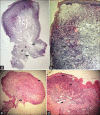An aggressive pyogenic granuloma masquerading as a vascular neoplasm
- PMID: 32773980
- PMCID: PMC7307463
- DOI: 10.4103/jisp.jisp_459_19
An aggressive pyogenic granuloma masquerading as a vascular neoplasm
Abstract
Pyogenic granuloma (PG) is a benign lesion, with a female predilection, commonly associated with local irritation or trauma. We report an unusual, destructive case of PG, displaying excessive loss of blood and destruction of alveolar bone leading to the loss of maxillary anterior teeth in an 18-year-old female, compromising function and esthetics. The incisional and excisional biopsy specimen of this recurrent lesion obtained during a 5-year span was studied, which revealed an increase in vascularity and extensive proliferation of endothelial cells admixed with varying degree of inflammatory cell infiltrate. The clinical, radiographic, and histopathological diagnostic tools enabled to precisely diagnose the lesion as an aggressive variant of PG, distinguishing it from other vascular neoplasms. No recurrence has been noted during a 5-year follow-up. The clinicians should be aware of the aggressive and destructive clinical behavior of PG to avoid the inadvertent treatment of this reactive lesion.
Keywords: Aggressive; pyogenic granuloma; recurrent; vascular neoplasm.
Copyright: © 2020 Indian Society of Periodontology.
Conflict of interest statement
There are no conflicts of interest.
Figures





References
-
- Mastammanavar D, Hunasgi S, Koneru A, Vanishree M, Surekha R, Vardendra M. Aggressive pyogenic granuloma: A case report. Int J Oral Maxillofac Pathol. 2014;5:29–32.
-
- Mohan M, Karikal A, Bhat S, Padmaja A, Thilak G. Aggressive pyogenic granuloma causing bone erosion. A case report. Healtalk. 2012;4:12–4.
-
- Martins-Filho PR, Piva MR, Da Silva LC, Reinheimer DM, Santos TS. Aggressive pregnancy tumor (pyogenic granuloma) with extensive alveolar bone loss mimicking a malignant tumor: Case report and review of literature. Int J Morphol. 2011;29:164–167.
Publication types
LinkOut - more resources
Full Text Sources
